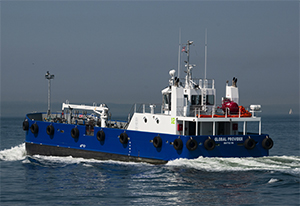The traditional system for refueling ships at anchor or dockside by a push tug and bunker barge is so well established that many American mariners would conclude this must be the only way to get the job done. The launch in Puget Sound of Global Provider, a 127-foot self-powered tanker, proves otherwise. With the capacity to deliver 150,000 gallons, this bunker boat challenges the standard procedure and offers many advantages to owner Maxum Petroleum, one of the largest independent energy logistics companies in North America.
Maxum has facilities in most major ports on the West Coast and has operated conventional fuel barges since it was founded in 1946. Four of these are identical hulls with 420,000 gallons of capacity; the fifth and newest is the 630,000-gallon Global Pilot, based in Seattle. That major northwest port is also the home of Elliott Bay Design Group (EBDG), which designed the vessel, and Vigor, which built it. Launched in 2014, this 219-by-54-foot tank barge has a lubricant capacity of 14,000 gallons in deck-mounted ISO tanks, and a fully equipped tankerman’s cabin with an office and control center. It provides fuel for ships of all types and sizes in Puget Sound.
 |
|
Capt. Brett Arseneau guides the tanker to another job on the Seattle waterfront from the well-appointed bridge. |
However, Seattle is the home port for a unique mix of smaller vessels, including ferries, long-haul tugs and articulated tug-barges, factory processors, and trawlers that moor at busy docks where there is not sufficient space for Global Pilot and its tug to maneuver. Mike Auer, Maxum’s environmental compliance manager, explained that this fleet has depended on refueling by land via tank trucks that typically carry a maximum of 8,800 gallons.
This may require a dozen or more visits, with the crew continually coupling and uncoupling hoses and dealing with each truck driver’s paperwork, he said. The process can occupy an entire day, and it demands that the crew maintain strict safety standards for each truckload. Maxum’s management recognized this situation as an opportunity to introduce a new class of fuel-transfer vessel: a small self-contained ship that combined tug and barge functions and could replace the repetitive road-based supply method.
They took this concept to EBDG, which studied the idea. After working closely with Maxum’s management and engineering staff, the naval architects proposed a barge-type double-hulled vessel under 90 meters to comply with ABS load line and ABS Subchapter D rules. After more discussions, the dimensions were set at a length of 127 feet, a 32-foot beam and a 13-foot molded depth with a 10-foot draft. Global Provider was given a capacity of approximately 150,000 gallons, yet measures under 100 gross tons to qualify as a two-person day-boat operation. The deck layout prioritizes ease and safety of operation with the latest systems to ensure the secure transfer of fuel and lube oil.
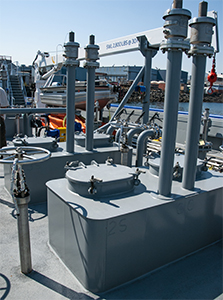 |
 |
|
|
Global Provider’s tankage offers a floating supply line for vessels that previously may have relied on dockside trucks for refueling, which is more time consuming due to increased coupling and uncoupling of hoses. |
Crewmember Scott Hallett prepares couplings as Global Provider gets ready to take on a load of bunker. A hydraulically driven diesel pump from Blackmer keeps the product moving. |
“We wanted a versatile vessel that would provide the highest level of environmental protection and compliance, and allow us to quickly and efficiently serve our diesel and lube oil customers in Puget Sound,” said Michael Curry, director of marine operations at Global Marine Transportation, a Maxum company. “This new boat with a lightship displacement of 325 tons will be able to more efficiently handle our factory processor and ATB tug customers. While oil barges typically target the deep-draft commercial sector, Global Provider is sized to service a wider range of vessels and avoid the problematic overflow and stormwater risks associated with refueling by multiple tanker trucks.”
To ensure maneuverability when coming alongside in tight berths, Maxum specified the vessel should have twin screws and twin Deflector Marine high-lift flap rudders, which were also designed and built in Washington state.
The EBDG team worked closely with all parties involved on the concept and contract design, on regulatory support and production engineering. Global Provider’s barge-type hull features six pairs of cargo tanks, with marine gas oil (diesel) in 12 tanks filling the main deck, and 24,000 gallons of lube oil carried in two pairs of 6,000-gallon tanks under the foredeck area.
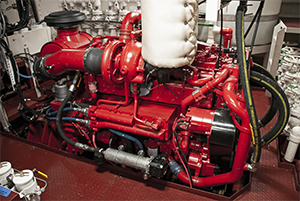 |
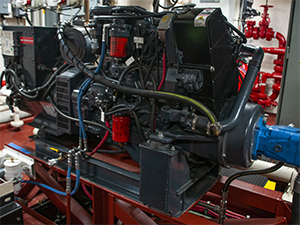 |
|
|
At the heart of the tanker is a pair of Cummins QSK19 diesels (left) that delivers a combined 1,320 horsepower, and two 65-kW Northern Lights generators (right). |
||
All pumps, valves and controls for each tank set are grouped together for ease of use and safe operation. The petroleum products are transferred by Blackmer hydraulically driven pumps manufactured in Waukesha, Wis. Tank-level monitoring is by the latest Bergan Guard Level electronic system that provides level, pressure, temperature and alarms. Data is displayed on the unit and also sent to a touch screen on the bridge as part of the vessel-wide safety system to prevent even the smallest spill. Firefighting capacity includes two ANSUL 400-gpm fire pumps delivering water to a pair of monitors capable of projecting a powerful stream that can be mixed with a foam solution held in a 300-gallon tank.
In the engine room, two Cummins QSK19 EPA Tier 3 diesels produce a combined 1,320 hp at 1,800 rpm, with redundant fuel and control systems. These inline six-cylinder engines turn four-blade, 48-inch, fixed-pitch propellers via Twin Disc MGX-5170DC gears with a 3.12:1 reduction ratio. A pair of Northern Lights 65-kW generators, also built in Seattle, meets the boat’s electrical power requirements. The fuel tanks carry 8,900 gallons and are located port and starboard of the engine room. Trim tanks are located in the forepeak and the stern quarters with a capacity of 12,000 gallons.
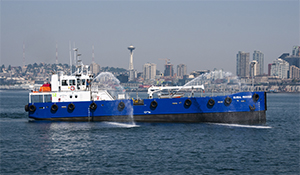 |
|
Global Provider’s crew operates the tanker’s ANSUL fire monitors during a demonstration in Puget Sound. |
Global Provider also has a full set of barge gear, including a Rapp Marine HP30 5F crane with 2,000 pounds of capacity to handle the hoses, and a 14-foot Stabicraft aluminum double-walled tender. J.K. Fabrication supplied a 21-26C hydraulic anchor winch, and a complete range of spill-response equipment — including oil boom and absorbent materials — is stored on deck and in lockers ready for deployment. A FLIR M625CS thermal imaging camera is mounted above the bridge, and FLIR CCTV cameras monitor the engine room and aft deck.
The bridge is equipped with a dual Furuno NavNet navigation system, and the helmsman also has a traditional Ritchie compensated compass as well as a Furuno satellite compass. Steering is by an AutoNav electrohydraulic tiller with two wing stations connecting to the powerful Deflector flap rudders. The masthead stands 43 feet above the waterline, but it is hinged and can be lowered to 25 feet.
There are accommodations and a galley for four crewmembers, making longer runs possible. “We have one barge each on the Columbia River and in San Francisco Bay,” Curry said. “If we have a barge in the dry dock in any of these ports, we can send this boat down as relief.”
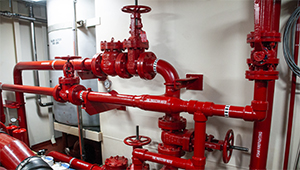 |
|
Piping below deck guides water and foam from two pumps at up to 800 gallons per minute. |
At Maxum’s Harbor Island fuel dock on Elliott Bay, Global Provider moors ahead of Global Pilot and faces the downtown Seattle waterfront with its mixture of old and new buildings. These two vessels also represent two very different approaches to providing marine fuel service. Global Provider is truly a little ship, although it has less than one quarter of the capacity of Global Pilot. The bunker tanker’s bridge, engine room and accommodations are comparable to a modern long-haul tug, with a carefully planned deck layout that maximizes ease of use while meeting the highest safety and environmental standards.
“Global Provider is the result of years of collaboration between our Maxum team, our valued customers, Elliott Bay Design Group and Jesse Engineering (now Jesse Co.),” said Dan Kovacich, vice president of Maxum Petroleum. “Most of our customers take smaller deliveries, so the new boat will fill an important niche.”

